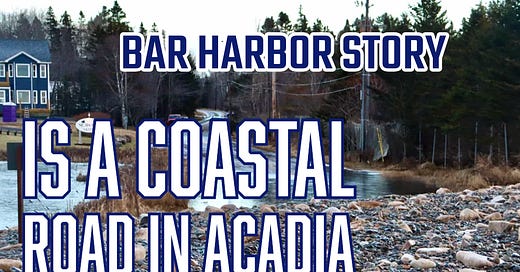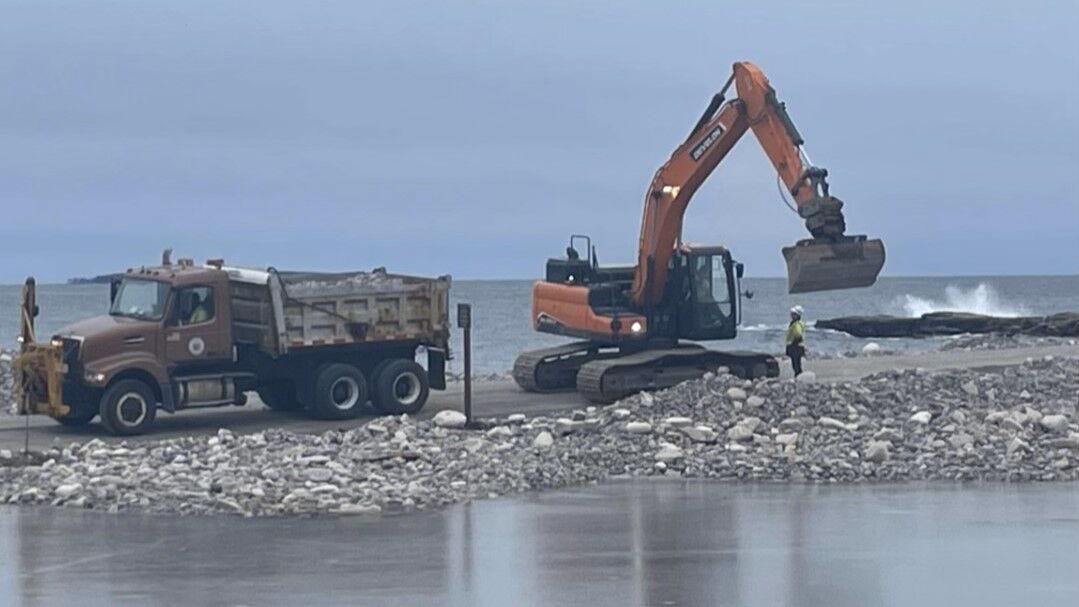Is a Coastal Road in Acadia That Keeps Washing Out Worth Saving?
State and federal agencies are debating how to fix a stretch of Seawall Road — or whether to abandon it altogether. by Jacqueline Weaver of the Maine Monitor
SOUTHWEST HARBOR—The fate of a flood-prone stretch of road on Mount Desert Island is up in the air as state and federal agencies debate whether to repair a road that washed out repeatedly during recent storms or abandon it to the sea.
What happens to this portion of Seawall Road — a half-mile stretch of Route 102A that lies between the Seawall Motel and Acadia National Park’s Seawall picnic area — will be decided in the coming weeks as the Maine Department of Transportation, National Park Service, abutting towns and members of the public weigh in.
It is one of many tough conversations in Downeast coastal communities and across the state about whether to repair or retreat given sea level rise and strong storm surges.
Seawall Road, part of it sitting inside Acadia, has endured repeated washouts this winter. Its name hints at the problem as well as the source of its appeal: The road is built along a massive natural seawall composed of rocks thrust ashore by waves.
It took a significant battering during the Jan. 10 and Jan. 13 storms, leading the pavement to buckle and rocks from the ocean to amass in piles up to three feet high. It was hit again by the March 10 storm, with wind and high tides causing damage that again made it impassable.
This stretch was closed after the January storms and reopened in February, only to be shut down again after the March 10 storm.
“Right now the road remains closed,” a DOT spokesman said. “We are working with Acadia National Park to determine the best path forward.”
The road connects Southwest Harbor to Acadia National Park’s Seawall campground and picnic area, Bass Harbor Head Lighthouse and two popular trails: Wonderland and Ship Harbor, which offer opportunities for hiking, birding and examining tide pools. Anyone who wants to visit these areas now has to take a 25-minute detour through Tremont.
The NPS said the picnic area and campground sustained significant damage during the January storms, and visitors should watch for downed trees. The picnic area is open and the campground is scheduled to open May 22, as planned.
“There is definitely debris down, so people should be extremely careful,” said Amanda Pollock, an NPS spokesperson.
Next steps
Paul Merrill, director of communications for the DOT, which manages the road, said the department is evaluating what steps to take. One option is abandoning the road. Another is to repair and raise it.
“We’re still working through all the pros and cons, all the options,” Merrill said. “There is an option to abandon the road but I don’t think it’s a preferred option right now, although it’s still on the table.”
He said discussions over the next few weeks will include the DOT, NPS, Southwest Harbor and Tremont town leadership, and the public.
Scott Alley, the Southwest Harbor road foreman, said the closure means his plow crews have to drive through Tremont to work the other end of Seawall Road.
“I think the town would like to see the road put back there,” he said.
He said his understanding is the NPS would like to preserve the rounded stones washed up by the waves, while the DOT prefers jagged rocks designed to minimize erosion.
Neither the NPS nor DOT were willing to comment.
“The main topic of discussion is not the stone,” Pollock said. “We’re looking at long-term solutions.”
Local concerns
What a permanent road closure could mean for businesses near the damaged stretch of Seawall Road is unclear. There’s a motel, a camping supply store and two take-out places, among others.
Charlotte Gill, who owns Charlotte’s Legendary Lobster Pound, just up the road from the stretch in question, bought the Seawall Motel and TideWatch Suites three years ago. The lodging abuts Acadia and includes about a third of the freshwater Seawall Pond.
“Closing the road down would effectively kill business, every business, on Seawall Road,” she said. “It would turn it into a dead end.”
As it is now, Gill said, cars are parking on her property and another across the road to walk along the closed stretch of Seawall Road. She said visitors are picking up rocks that washed ashore and throwing them into the pond, disturbing a rich and delicate ecosystem.
Dawn Raymond, owner of Seawall Camping Supplies — which offers firewood, supplies and coin-operated showers to people staying at Seawall Campground — said she believes officials will consider local businesses and decide against closing the road.
“They’ve paved this road over many times. It’s just the nature of it,” she said. “They are just going to have to keep fixing it.”
David Lloyd, who used to own Seawall Motel and still lives next door, said his major concern is that the 22-acre pond be protected. He said it has an unusual ecosystem that includes freshwater plants and fish, a spruce forest and carnivorous plants.
Critical to the pond’s stability, he said, is maintenance of a culvert the DOT installed when the state built Seawall Road in the 1920s, with the aim of preventing flooding.
There’s also a question of public safety. The town of Tremont, which is currently covered by the Hancock County Sheriff’s Office, is set to decide in May whether to contract with the Southwest Harbor Police Department.
But Southwest Harbor police chief John Hall said the road closure would not affect his department’s ability to provide emergency services to Tremont, should the town vote in favor of the contract.
“It doesn’t hinder our operation,” Hall said. “We will just drive a different route.”
Marilyn Lowell, the Southwest Harbor town manager, said the DOT planned to pave the road this spring but damage from the March 10 storm means that is likely off the table.
Jesse Dunbar, the Tremont town manager, said keeping Seawall Road closed will greatly increase traffic going through Tremont.
State Rep. Nicole Grohoski wrote Dunbar and Lowell in early April to reassure them the DOT will take the towns’ perspectives into account.
“I have been assured that both Southwest Harbor and Tremont town leadership and community members will be included in the conversation about the options they are reviewing now,” she wrote. “They will not make any decisions before the public is involved.”
BAR HARBOR STORY PHOTOS OF SEAWALL
RELATED STORY: Coastal towns, businesses contemplate whether to rebuild or retreat
Editor’s Note: We have a sharing agreement with the Bangor Daily News and also The Maine Monitor. When there are stories that are about wider issues and/or that they’ve already covered really well and we think that you might want to read them, or they might help the community out.
This story was originally published by The Maine Monitor, a nonprofit and nonpartisan news organization. To get regular coverage from the Monitor, sign up for a free Monitor newsletter here.












It's a legitimate question.... I don't think that the businesses along seawall will suffer... they may even become more popular if that section of seawall was a walking/bike path. The 'dead end' reasoning doesn't hold that much credence. It might even benefit the lobster pound with less complaints! The bigger issue is safety from natural catastrophe... ie.. can people exit safely from either side.